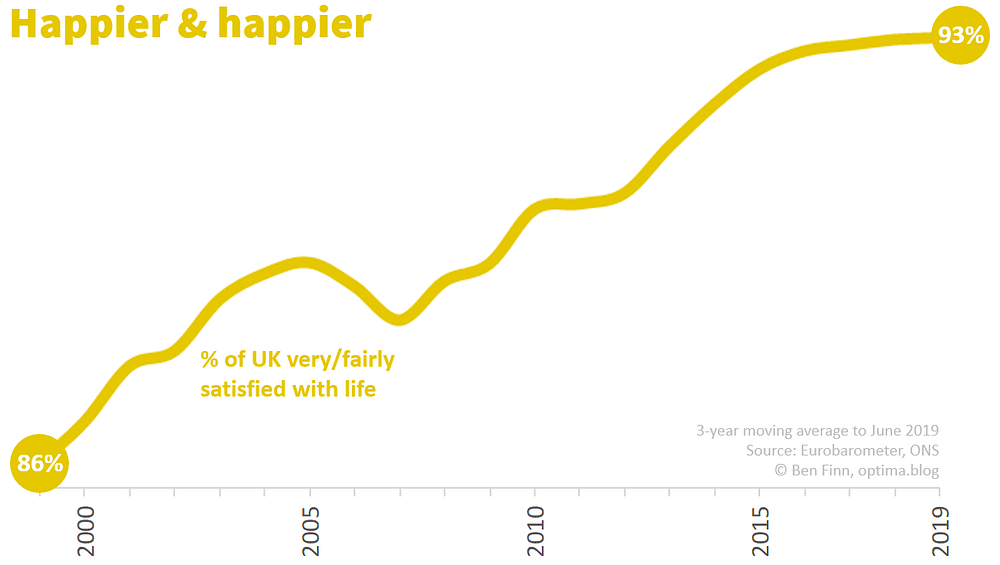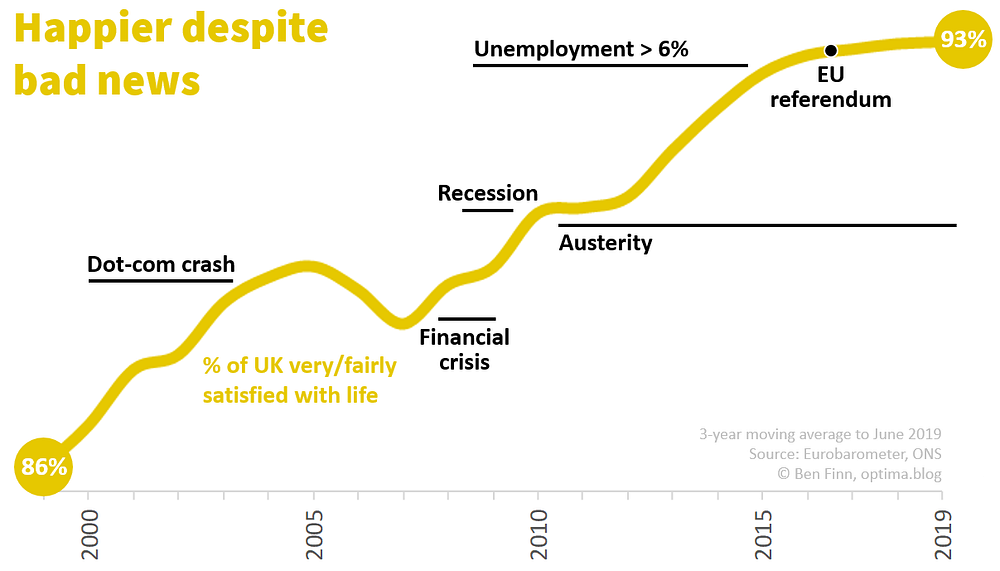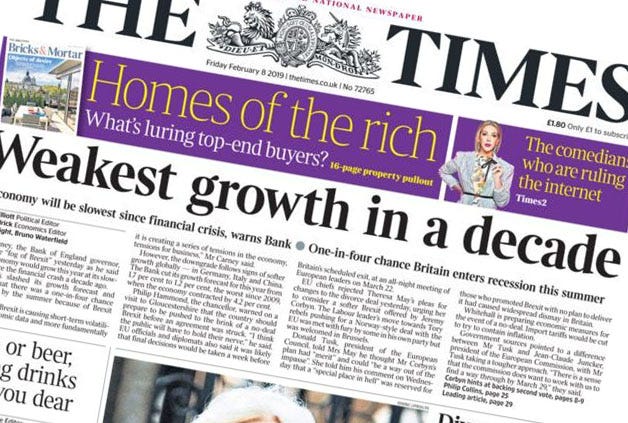LIFE IN THE UK has got much better since the millennium, largely unnoticed. For despite financial & political chaos, austerity, terrorism, wars, and fears about Brexit and the environment, Britons have got happier and happier — probably happier than at any time in history.
How can this be?

This yellow line sums up the experiences of millions of people over 20 years, asked how satisfied they are with their lives.¹ When answering, they take into account whatever matters to them — relationships, health, work, money, and everyday joys and woes of all kinds. It’s subjective; but so is life. And 93% of them say they’re happy — despite endless bad news, particularly about the economy:

For some reason, happiness climbed through crashes, crises, recession, unemployment, and austerity cuts; even the EU referendum didn’t stop the rise.
What about the unhappy, though? We should have most concern for the worst off. Here’s a summary of all the misery over the same period — the bereavements, tragedies, firings, failures, depressions, illnesses, heartbreaks, and crimes:

This shows that levels of misery — those not at all satisfied with life — fell from 3% to just 1% of the population.² It has even halved during austerity! (Which doesn’t mean austerity made misery fall, but for some reason it hasn’t prevented it falling, either.)
What is going on here? If this doesn’t fit your worldview, you may be inclined to dismiss it with a wave of the hand, as a statistical error or trick.³ But global happiness research helps us understand it. I’ll go into detail later; but it suggests that economic bad news wasn’t that relevant, and was offset by larger but less obvious improvements in society. After all, there’s more to life than money.
The graphs above cover the last 20 years, but it’s worth looking at the longer term, too:

During the 1970s, ’80s and ’90s, the proportion of happy people hovered around 85%, despite huge changes in the UK. But since then it has climbed, and Britons are now the happiest they have ever been.⁴ Even more importantly, the blue line shows misery has fallen to one-quarter of 1970s levels.

Why happiness matters
Happiness is not just something nice to have, alongside a job, car and iPhone. Many philosophers, ancient and modern, regard it as the only thing that matters.⁵ As Aristotle said, “Happiness is the meaning and the purpose of life, the whole aim and end of human existence”. This doesn’t amount to selfish hedonism, for everyone’s happiness, both present and future, counts— not just your own.⁶
Each of us has our own yellow happiness line with its own shape. And each of us spends our waking hours trying to nudge our line, and those of others we care about, upwards. Work, relationships, leisure, self-improvement, volunteering — everything we do, in fact, from eating breakfast to watching sunsets — tries to increase happiness and reduce misery. Humans have pursued happiness since the dawn of time; indeed, the whole reason such emotions evolved was to coax us into helping ourselves and others — and thereby avoid loneliness, hunger, cold, illness, and death.
This is why these graphs are the best measure of progress in modern Britain. They sum up everything that governments, charities, businesses, religions, schools, and millions of individuals have done to improve their lives and those around them. They also show that these efforts have succeeded.
Of course, the UK is not perfect, otherwise everyone would be very happy. We are not there yet. But this is a dramatic improvement in just a few decades — and one which requires explanation.
These statistics are part of a vast international effort to understand and improve happiness; it’s a new science, combining psychology, economics, philosophy and politics. Over 150 countries now conduct similar surveys; the Nordics are happiest of all, the UK not far behind, and developing countries (mostly African) are the least happy. From this data, economists are working out what causes happiness: for example, health and relationships are major factors, as is income in poorer countries — though it’s surprisingly unimportant in rich ones.
Such findings can help governments nudge yellow lines up, and blue ones down. Britain, France, Italy, New Zealand and the United Arab Emirates are starting to use happiness and well-being to guide policies, in place of less relevant economic measures; for GDP, inflation, and so on only matter insofar as they affect citizens’ happiness.

So, why has Britain got happier?
The notion that we’re declining from some Golden Age of our childhoods is mistaken; memory plays tricks on us. In reality, life used to be much worse, in many ways.
Health
Britons are far healthier than in the early 1970s, when many still endured Dickensian conditions, lives were nine years shorter, and (believe it or not) one-third of adults had no teeth. Mental health, which is even more important for happiness, may well have been worse too;⁷ these days, depression and anxiety are less stigmatized, treatments are better, and suicide is rarer. So, health improvements probably account for much of the fall in misery.
Equal opportunities & rights
A country’s culture is another major influence on happiness, though the specifics are harder to pin down. Here are some that may be important in the UK.
Social attitudes used to be deplorable. In 1975, viewers were flabbergasted to see the Nine O’Clock News being read by — a woman! Much other telly, from Benny Hill to The Black and White Minstrel Show, would be unbroadcastable today. Homosexuality was a shameful secret. Disabled people stayed out of sight. Discrimination was widespread.
There has been a revolution in attitudes and legislation since then, which has slashed discrimination and given people more control over their lives. This is most obvious for women, who now have the same educational and career opportunities as men. But more widely, Britons’ rights are more respected (and enforced by the law), so they suffer less oppression and injustice, from domestic abuse to workplace bullying. A rough estimate suggests these improvements could account for much of the fall in misery⁸ — probably continuing to this day.
As health and discrimination improved so much in the late 20th century, it’s surprising that the yellow line hardly rose. Maybe the worst problems were fixed first, helping those on the blue line rather than the majority. But in the 21st century, the yellow line has taken off — perhaps due to other improvements that affect most people:
Work & touchy-feeliness
Britons, who used to dislike work, now feel much better about it;⁹ and as they spend much of their lives working, higher job satisfaction should make them considerably happier.
People-friendly measures such as maternity & paternity leave, flexible working, team-building, corporate social responsibility, and tax breaks on creches, gyms and bikes, have no doubt played their part in this. Even Tube drivers no longer strike about pay and conditions, but ‘work-life balance’.
These changes are part of a growing, and distinctly un-British, touchy-feeliness. Emotions are now openly expressed on TV and social media. Snowflakes are everywhere, all year round. Mindfulness, positivity, yoga, hygge, life coaches, and self-help books assail us from all directions. And science suggests some of this is even a Good Thing — which presumably helps nudge the yellow line up.
It all seems quite a shift away from our traditional ‘stiff upper lip’. But that resilience may still explain why economic turmoil, terrorist attacks and other bad news didn’t hit harder. During the financial crisis, the forgotten wartime poster Keep Calm and Carry On struck a chord across the nation, and became wildly popular. This stoicism might even be a weather-hardened northern European characteristic — for happiness in Iceland and Ireland wasn’t much dented by their financial crashes, either.¹⁰
The Internet
Despite some harms (perhaps mainly to the young), the Internet may well have improved most people’s lives. Relationships are a major cause of happiness; and the Internet enables people to keep up with old schoolfriends, Skype their grandchildren, use dating apps, and interact with others who share interests. And the endless supply of free information, help and entertainment — from education and mental healthcare to cat videos — can certainly boost happiness. (Thanks to the Internet, I now enjoy Scrabble daily, instead of once a year.)
The economy & governments
The financial bad news on the charts was misleading. Many people, from economists to environmentalists, now question the relevance of measures like GDP, and the relentless pursuit of growth. This is because the more you have, the less difference extra money makes to you. Once basic needs are met (e.g. food, shelter, health), other purchases are mere icing on the cake; and the best things in life are free.
Indeed, research shows that UK incomes, which after significant falls have recovered to all-time highs,¹¹ are large enough that people’s happiness hardly depends on them¹²: those on low incomes are almost as happy as the rich. This probably explains why happiness climbed despite all the financial turmoil — money isn’t that relevant in Britain any more. The main cause of misery nowadays isn’t low income, but poor health. (So give spare money to carefully–chosen causes where it can do more good — and makes donors happier, too.)
This is not of course to recommend financial turmoil, without which no doubt the UK would be happier still; e.g. the fall in misery stalled from 2006 to 2011. The research does, however, endorse a shift from traditional economic indicators to ones of happiness, which are starting to appear in policy documents. This is also in governments’ own interests, as raising happiness is more likely to get them re-elected than improving the economy.¹³
How have UK governments fared at this? The graph since 1973 suggests that Labour and Conservative-led administrations have been equally good at maintaining or raising happiness, and tackling misery, at least in the short-term; though it’s harder to know the long-term effects of policies. Note that the happiness rise coincides with more centrist policies, from the minimum wage to gay marriage — so perhaps they work better. But it would be a mistake to attribute too much to governments, as they have little control over many aspects of society, from relationships to the Internet.

Why so surprising?
Why does it seem odd that happiness has risen? Aside from the curious unimportance of money, I propose three reasons: the news is completely misleading; people don’t notice gradual improvements; and they vastly underestimate how happy everyone else is.
News
The media focusses on the bad, not the good. Horror stories about zero-hours contracts, the gig economy, and harsh practices at Amazon highlight exceptions—as most Britons have become much happier with work. Reports of viruses, online bullying, privacy breaches, and cybercrime ignore the Internet’s huge benefits. Bad news grabs attention, but is unrepresentative. Good news is bland, and largely ignored; BBC newsreader Martyn Lewis once attracted ridicule for suggesting that more of it be broadcast.
Much of the news is a daily soap opera about politicians and celebrities, or rare, extreme events that affect few people. News outlets pander to their demographic’s opinions, or spin stories to suit their own agendas. And social media exacerbates it, with algorithms that select the most surprising, shocking clickbait to chuck at your eyeballs.
In short, news has a hopelessly distorted worldview; it needn’t be fake to be highly misleading. Most of what makes life worth living is left out; everyday pleasures are not newsworthy. Of 66 million Britons, the vast majority lead largely happy lives that never make headlines.
Health, rights, attitudes and work have improved slowly enough not to be noticed year to year; though over decades, they add up to huge progress. Such gradual improvements are less newsworthy than financial crises & terrorist attacks. Any coverage is likely to be of short-term blips and details that can be portrayed as bad news, rather than large-scale trends — the trees instead of the wood. So people don’t hear about long-term improvements, or just take them for granted.
Perhaps because of the news, people assume others are far less happy than they really are, as worldwide research shows. They typically think only half as many are happy as is the case — a massive misperception. Similarly, I’ve asked people what proportion of Britons they thought were ‘not at all satisfied’ with life. Most guessed around 10%; the lowest was 5%. (What would you have said?) No-one got anywhere near the true figure — just 1%.
The many shortcomings of news don’t mean you should ignore it entirely. Important issues that affect you, or that you’re likely to do something about, are worth your attention. But an indiscriminate diet of news is as bad as junk food.
The future
Why haven’t two big current issues — Brexit and climate change — pushed happiness down? Because their potential harms lie mostly in the future. The surveys ask how satisfied people are with their own lives nowadays — not with other things (e.g. government policies), nor to speculate about others’ happiness, or the future. So the yellow & blue lines depict people’s past and presentlives, not where they may lead.
You may think people shouldn’t feel happy when there are still big problems in the world; but happiness needn’t lead to complacency. You can be happy with your own present situation, while having concern for others and for the future — especially if you act on it. Indeed, if you were too caught up in your own problems, you couldn’t do anything about global ones.

Conclusions
Britain has got happier, and misery has fallen dramatically. But many haven’t noticed, because bad news (especially economic) is misleading, and people mistakenly assume others are unhappy. Gradual improvements to health, equal opportunities, rights, attitudes, work, and technology are less newsworthy than crises, but over decades their effects are much greater. Though some things have got worse, in most respects the UK is far better than it once was; and most people now lead long, happy lives that never make headlines.
This shows what the efforts of millions can achieve in just a few decades. The yellow line could fall if we’re not careful — but that doesn’t detract from the fact that it has risen against the odds. By figuring out why, happiness research can help extend this rise into the future, and around the world.
If you found this article half-interesting, please scroll to the bottom to share or subscribe.
[1] Life satisfaction is one of several measures of well-being; others include behaviours & emotions (e.g. laughing, anxiety), and feeling you are doing worthwhile things. Life satisfaction is reckoned to be the best subjective measure, as it encompasses everything else, and is more stable; I will also refer to it as ‘happiness’ (though academics often call positive emotions ‘happiness’ instead). The yellow line shows the proportion of respondents to the Eurobarometer survey (to 2011) who said they were very or fairly satisfied with their life nowadays; and from the Office for National Statistics survey (2012–19) whose satisfaction was medium, high or very high (with the medium percentage scaled by 0.79 as best fit to the Eurobarometer data since 2011). The ONS data is preferable as it’s a larger, more frequent survey.
[2] Those not in either graph, making up the rest of the 100%, are the people ‘fairly dissatisfied’ with their lives; around 12% in 1999, 6% today.
[3] E.g. if you doubt the validity of these surveys, Eurobarometer are Europe-wide surveys carried out by the EU since 1973. The UK’s Office for National Statistics is independent from government, and since 2011 has conducted the most elaborate well-being surveys of any country. Both organisations’ datasets are widely used in academic research and correlate well with each other.
[4] The only earlier UK survey, in 1948, found 66% were very/fairly satisfied with their lives; and as health & much else were worse back then, it is unlikely this figure was ever above 93% throughout history.
[5] The main other ethical theory involves following moral rules (e.g. the Ten Commandments). But in practice this usually produces similar results, as the rules tend to be designed to increase happiness and avoid misery.
[6] Animals are usually included too (in the form of animal welfare).
[7] The prevalence of mental health problems is hard to quantify, as better recognition and less stigma could make more people report them over time even if actual prevalence is declining. The Adult Psychiatric Morbidity Survey shows common mental disorders rising 1993–2014; but the suicide rate, a more objective measure, fell by 14% over the same period, and by 24% 1981–2018.
[8] The main groups — women, non-white, LGBT, and disabled people — totalled around 75% of the population (double-counting those in more than one group, as they would be more affected.) If they had a higher than average misery rate in the early 1970s — say, 5% — which greater equality and tolerance have since halved, that would reduce total misery by about 75% × 5% ÷ 2 = 1.9% of the UK population, or more than half the total fall in misery.
[9] The proportion satisfied with work rose by nearly half between 2002 and 2016/17, from 38% to 56%, and those satisfied with income rose from 31% to 46%. (Source: ONS)
[10] UN World Happiness Report 2017
[11] By 2017/18, median income was at an all-time high; the bottom decile (i.e. the lowest 10% of incomes) was 3% below its previous high. Both were about 40% higher than at the turn of the millennium (and double 1970s levels). This is after adjusting for CPIH inflation (including housing costs), taxes, and benefits in cash & in kind; so it also takes into account various austerity cuts. (Source: ONS)
[12] The Origins of Happiness by Andrew Clark et al. (2018)
[13] UN World Happiness Report 2019
Photos from Shutterstock.com
